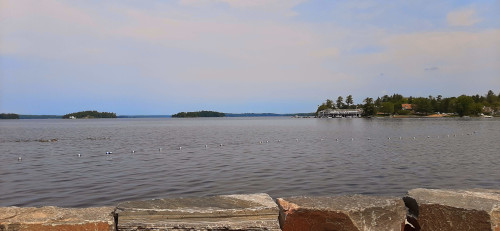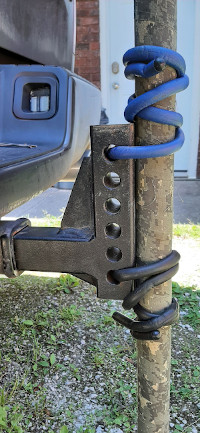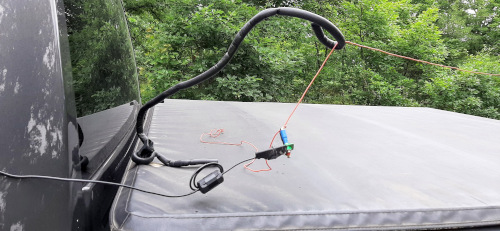The XYL and I took a short break from routine and drove up to Ontario’s Muskoka region for 4 days of recreation and radio activity. I packed my QRP Labs QMX transceiver and a selection of antennas hoping to complete a couple of POTA activations.

Muskoka is the playground of the wealthy with many large, impressive waterfront cottages and many small boats. The weather was hot by Ontario standards; each day was sunny and over 30 degrees Celsius (86 Fahrenheit). The first couple of days was spent trying to stay cool. A 2-hour cruise on Lake Muskoka aboard the reproduction 19th Century mail ship Wenonah 2 certainly helped. In the picture above the Wenonah 2 (right) is moored alongside the restored genuine 19th Century mail ship Segwun.
Loon Lake CA-1488 – no go!
On the third day we set off for Loon Lake Wetland Conservation Reserve (CA-1488). Loon Lake is a small lake to the south west of Lake Muskoka. There were once plans to dig a canal through Loon Lake to link Lake Muskoka to the Trent-Severn Waterway. Those plans never came to fruition and Loon Lake is now surrounded by small private cottages with no public access to the waterfront. I searched for a suitable site where I could set up to do an activation, but apart from a small roadside parking space away from the lake with power lines running right over it, I was unsuccessful. There are no indications where the park boundaries lie either. Loon Lake has been activated three times, perhaps by cottagers, who knows.
We drove back into the Town of Gravenhurst to find an alternate location to play radio. There is an excellent park that is the site of a former World War 2 prisoner-of-war camp where high ranking German officers were detained. It was very interesting but again not a good location for setting up. We moved on to another small public park at Muskoka Beach.

Muskoka Beach park sits right on the shore of Lake Muskoka with a great view out over some of the many islands in the lake. To the right of the picture above is the exclusive Taboo resort where an overnight stay will cost enough to finance the purchase of almost everything QRP Labs makes. We stayed at the more modest Howard Johnson hotel.

We had the park to ourselves so I decided to set up and do some POTA hunting. I chose my trekking pole mounted vertical antenna, and here is where lesson number 1 was encountered. Muskoka lies at the southern end of the Canadian Shield and that means bedrock is everywhere. There was a thin layer of soil with well-maintained grass in the park but my trekking pole would only penetrate a couple of inches into the ground. I tried several locations and finally saw a small, young tree. Figuring that the tree was probably planted in an excavated hole, I went ahead and probed the ground there. Fortunately the idea paid off and up went my antenna.
I laid out 25 feet of RG-316 to a nearby picnic table and proceeded to set up my radio. Then came lesson number 2. I planned to use my Talentcell Lithium Ion Phosphate battery, but when I pulled out the connecting cable (with 2 series diodes to drop the voltage to within the limits the QMX will tolerate) I found a broken wire.
A Case for Perry Mason?

I had invested a big US$1 to buy the 2.1mm x 5.5mm molded plug with 6 inches of red and black DC power wires from QRP Labs. When I received it I was surprised by the very thin stranded copper wire inside the insulation. Maybe it was sufficient to carry the maximum 700mA drawn by the QMX but, as I discovered, it has absolutely no physical strength. The Big Blue Sky Shack is a tough environment for equipment and this component wasn’t up to the task.
I had crimped 15A powerpole connectors onto the wires. The red wire broke during transit; when I got home I gave a short sharp tug on the black wire and it surrendered without resistance too. My team of lawyers will be in touch with QRP Labs in the next few days.
The Talentcell battery puts out a voltage that is a little high for the QMX, but now I didn’t have my diode voltage limiters, so I pulled out my home-made Lithium Ion battery from my backpack. The Lithium Ion battery contains three 18650 cells in series which produces 12.3 volts. The cells are recycled from old laptop batteries and other sources, so I wasn’t sure how well they would hold up. I needn’t have worried, the QMX purred along powered by this battery and I was able to successfully hunt some POTA activators.
Two successful POTA activations and a very wet drive home
The next day was the final day of the trip and time to head home. The weather was very unsettled, cooler than the previous three days with heavy rain in the forecast. En route lay a couple of provincial parks I had already activated on a previous trip. The first was Hardy Lake Provincial Park (CA-0227). Although I prefer to operate completely outdoors, the local infestation of deer flies made that impossible. Deer fly bites can be quite painful so I operated from inside my truck with my vertical antenna mounted on the side wall of the truck bed.
Don’t Worry, Be Happy!
Two things were causing me to worry. First, would my recycled Lithium Ion battery pack make it through the activation? And, secondly, the propagation forecast for 20m was “poor”. It was a struggle to get responses to my CQs. I could see that the QMX was putting out full power by looking at the bar graph display. The voltage during transmit was holding at 11 volts so my first worry subsided. Despite poor propagation I managed to get the required 10 QSOs in only 18 minutes. Although that was twice as long as usual, it wasn’t at all bad. I carried on calling to get some “insurance” contacts, but after 12 QSOs I called QRT to preserve battery power and move on to the next park before the rain had a chance to start.
Dark sky at night, astronomers delight
A short drive took us on to Torrance Barrens Conservation Reserve (CA-1669). This park is a dark sky reserve popular with astronomers. It is also a site where the bedrock comes to the surface over a large area. It was fascinating to see acres of floor laid down by nature billions of years ago. Remembering the tough propagation conditions, I chose my End-Fed Half Wave (EFHW) antenna for this activation. The sky was heavy with impending rain and once again the deer flies were aggressive, so it was to be another in-truck activation.

There were other vehicles in the parking lot (a small uneven patch of bedrock) so I was constrained in how I could configure my antenna. I used my fiberglass pole mounted on the truck’s hitch by a home made contraption. This contraption worked but it was too heavy, too bulky and the pole had to be fed through the tube from the bottom before the hitch was mounted to the truck.

Another lesson learned – Keep it sweet and simple! After returning from the trip I devised a much lighter and simpler way to support my pole.
I know some people like to use a hitch mount flag pole support, but I looked at one over the Field Day weekend and decided it would be no improvement over my old design.
The EFHW wire is 31 feet long, but the pole is only 29 feet tall so I wound the wire loosely around the pole to take up some of the slack. Then, in the best MacGuyver tradition, the remainder of the wire and my home made 49:1 transformer was suspended above the truck bed (see photo).
A short length of RG-174 coax connected the antenna to the QMX inside the truck and we were ready for some further POTA action.

OMG! … Whassat?
The antenna didn’t look very elegant but it did attract the attention of another park user who gawked at it in disbelief. It may also have been less efficient than if it had been erected properly, but it did the job on the day. I must devise an improved way to erect the EFHW above the truck for the future. Every activation is a learning experience.
Going Down Slowly
The Lithium Ion battery was now down to 11 volts, dipping to 10 volts on transmit and the bar graph on the QMX display was showing that it was putting out less than its maximum power. Nonetheless, the required 10 QSOs were completed in 26 minutes. The final caller gave me an RST report of 519 from North Carolina so I figured my RF power was dropping down, maybe a bit too low. Time to quit – especially as the predicted rain was starting. On the way home the rain came down in torrents so I was glad I completed my radio activities early.
It was a fun trip overall and I was pleased to get a couple of POTA activations in the log. Now I have some work to do to iron out the shortcomings in my equipment. I have already replaced the defective DC power lead with heavier gauge wire and built the diode voltage limiter cable strong enough to survive battle. I also included a tap so that I can choose one diode or both diodes – a simple way to adapt as battery voltage drops. Life is for learning!
I now have to engineer some kind of alternative support for my trekking pole mounted vertical antenna. I have a modified photographic tripod that might work, but there may be a better alternative. Thinking cap on John!
Help support HamRadioOutsidetheBox
No “tip-jar”, “buy me a coffee”, Patreon, or Amazon links here. I enjoy my hobby and I enjoy writing about it. If you would like to support this blog please follow/subscribe using the link at the bottom of my home page, or like, comment (links at the bottom of each post), repost or share links to my posts on social media. If you would like to email me directly you will find my email address on my QRZ.com page. Thank you!
The following copyright notice applies to all content on this blog.

This work is licensed under a Creative Commons Attribution-NonCommercial-NoDerivatives 4.0 International License.
It’s too bad that Loon Lake has no public access. Someone should have made space for the public but it’s probably too late to do anything now.
I am glad you had a good time at the other POTA sites. Dow at MY QTH, we only have mosquitos, but there are ways to keep them at bay. We have been having 35 to 40 degree heat, so any POTA outings sill have to wait to fall.
I really enjoy your blogs and thank you for writing them. 73
LikeLiked by 2 people
We have a lot of small lakes in Ontario that have no public access. The entire shore of these lakes is privately owned. Unfortunate but true. Thanks for the feedback David.
LikeLike
I would love to be back in Ontario. I loved it the times I have been there.
LikeLiked by 1 person
Sounds like a nice outing with the QMX.
Here’s another “lesson” I’ve learned about the QMX – if you have a perfectly matched antenna connected and you put your phone next to the radio, close to the coax connector, you will trip the SWR protection.
I assume the RF from the phone is getting in on the shield and overloading the SWR measurement transformer.
72 de W6CSN
LikeLiked by 1 person
Wow, that’s an interesting observation Matt. I often have my phone near the radio so I can monitor the spots page at pota.app. I’ll make sure it’s well separated from the QMX in future. My SWR Protection is set to 3.
LikeLike
Sounds like a great trip, John.
I use a 21 ft ‘crappy’ pole at the rear of my truck and a 7 ft pole at the front bumper when I use my end fed in locations with limited other options. It keeps my antenna off the truck and works fine on 20m.
YMMV
73
John, KF6EFG
LikeLike
That’s a good suggestion John, thanks. I have a 29ft fiberglass pole and a 13ft crappie pole. I’ll take both along on my next trip.
LikeLike